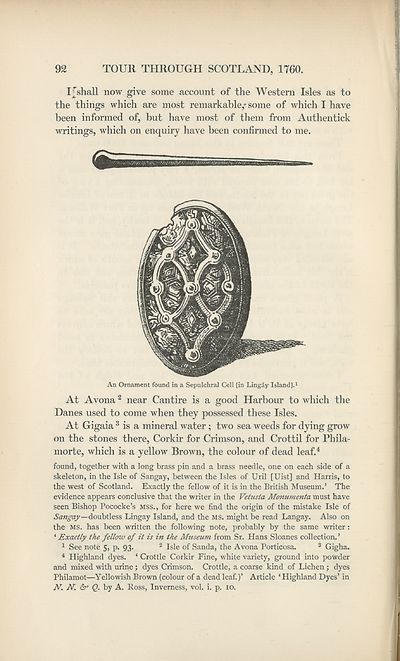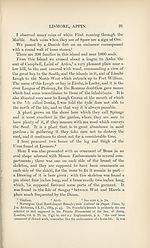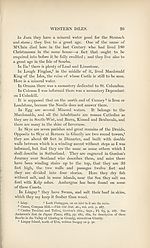Series 1 > Tours in Scotland 1747, 1750, 1760
(179) Page 92
Download files
Complete book:
Individual page:
Thumbnail gallery: Grid view | List view

92
TOUR THROUGH SCOTLAND, 1760.
Ushall now give some account of the Western Isles as to
the things which are most remarkable,-some of which I have
been informed of, but have most of them from Authentick
writings, which on enquiry have been confirmed to me.
An Ornament found in a Sepulchral Cell [in LingSy Island].1
At Avona 2 near Cantire is a good Harbour to which the
Danes used to come when they possessed these Isles.
At Gigaia 3 is a mineral water; two sea weeds for dying grow
on the stones there, Corkir for Crimson, and Crottil for Phila-
morte, which is a yellow Brown, the colour of dead leaf.4
found, together with a long brass pin and a brass needle, one on each side of a
skeleton, in the Isle of Sangay, between the Isles of Uril [Uist] and Harris, to
the west of Scotland. Exactly the fellow of it is in the British Museum.’ The
evidence appears conclusive that the writer in the Vetusta Monumenta must have
seen Bishop Pococke’s mss., for here we find the origin of the mistake Isle of
doubtless Lingay Island, and the MS. might be read Langay. Also on
the ms. has been written the following note, probably by the same writer:
‘ Exactly the fellow of it is in the Museum from Sr. Hans Sloanes collection.’
1 See note 5, p. 93. 2 Isle of Sanda, the Avona Porticosa. 8 Gigha.
4 Highland dyes. ‘ Crottle Corkir Fine, white variety, ground into powder
and mixed with urine; dyes Crimson. Crottle, a coarse kind of Lichen ; dyes
Philamot—Yellowish Brown (colour of a dead leaf.)’ Article ‘ Highland Dyes’ in
N. N Q. by A. Ross, Inverness, vol. i. p. 10.
TOUR THROUGH SCOTLAND, 1760.
Ushall now give some account of the Western Isles as to
the things which are most remarkable,-some of which I have
been informed of, but have most of them from Authentick
writings, which on enquiry have been confirmed to me.
An Ornament found in a Sepulchral Cell [in LingSy Island].1
At Avona 2 near Cantire is a good Harbour to which the
Danes used to come when they possessed these Isles.
At Gigaia 3 is a mineral water; two sea weeds for dying grow
on the stones there, Corkir for Crimson, and Crottil for Phila-
morte, which is a yellow Brown, the colour of dead leaf.4
found, together with a long brass pin and a brass needle, one on each side of a
skeleton, in the Isle of Sangay, between the Isles of Uril [Uist] and Harris, to
the west of Scotland. Exactly the fellow of it is in the British Museum.’ The
evidence appears conclusive that the writer in the Vetusta Monumenta must have
seen Bishop Pococke’s mss., for here we find the origin of the mistake Isle of
doubtless Lingay Island, and the MS. might be read Langay. Also on
the ms. has been written the following note, probably by the same writer:
‘ Exactly the fellow of it is in the Museum from Sr. Hans Sloanes collection.’
1 See note 5, p. 93. 2 Isle of Sanda, the Avona Porticosa. 8 Gigha.
4 Highland dyes. ‘ Crottle Corkir Fine, white variety, ground into powder
and mixed with urine; dyes Crimson. Crottle, a coarse kind of Lichen ; dyes
Philamot—Yellowish Brown (colour of a dead leaf.)’ Article ‘ Highland Dyes’ in
N. N Q. by A. Ross, Inverness, vol. i. p. 10.
Set display mode to:
![]() Universal Viewer |
Universal Viewer | ![]() Mirador |
Large image | Transcription
Mirador |
Large image | Transcription
Images and transcriptions on this page, including medium image downloads, may be used under the Creative Commons Attribution 4.0 International Licence unless otherwise stated. ![]()
| Scottish History Society volumes > Series 1 > Tours in Scotland 1747, 1750, 1760 > (179) Page 92 |
|---|
| Permanent URL | https://digital.nls.uk/126604905 |
|---|
| Attribution and copyright: |
|
|---|
| Description | Over 180 volumes, published by the Scottish History Society, containing original sources on Scotland's history and people. With a wide range of subjects, the books collectively cover all periods from the 12th to 20th centuries, and reflect changing trends in Scottish history. Sources are accompanied by scholarly interpretation, references and bibliographies. Volumes are usually published annually, and more digitised volumes will be added as they become available. |
|---|


